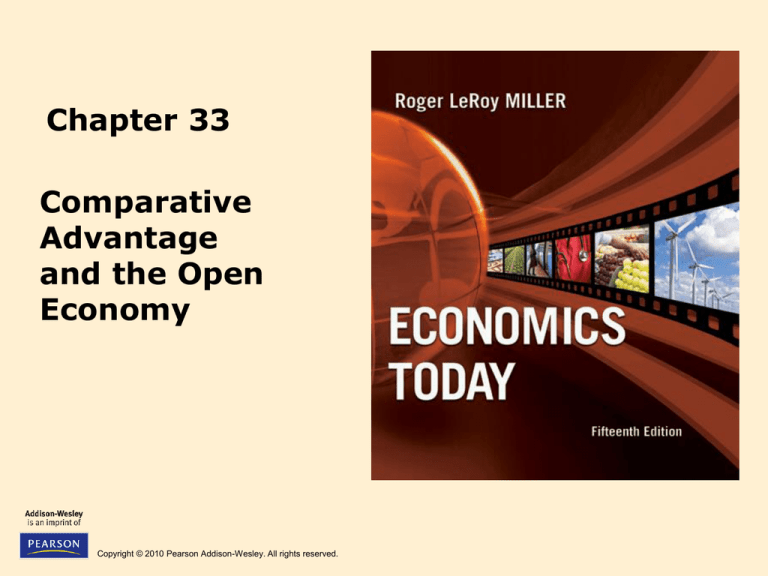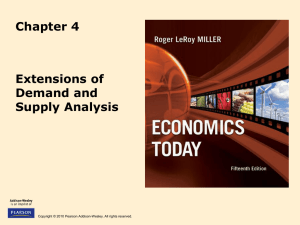
Chapter 33
Comparative
Advantage
and the Open
Economy
Copyright © 2010 Pearson Addison-Wesley. All rights reserved.
Did You Know That...
• Each year, U.S. residents spend more than $5
million on U.S. flags manufactured outside the
United States.
• This figure may fall somewhat in future years,
however, if some state governments have their
way.
• Some state governments have made it illegal to
sell U.S. flags manufactured outside of the United
States.
• What effects do restrictions on imports have on
quantities and prices of domestically produced
goods and services?
33-2
Copyright © 2010 Pearson Addison-Wesley. All rights reserved.
The Worldwide Importance of
International Trade
• World GDP today is nearly nine times
greater than it was at the end of World War
II.
• World trade has increased to more than 28
times what it was in 1950.
33-3
Copyright © 2010 Pearson Addison-Wesley. All rights reserved.
Figure 33-1 The Growth of World Trade,
Panel (a)
Source: Steven Husted and Michael Melvin, International Economics, 3rd ed. (New York: HarperCollins, 1995), p. 11,
used with permission; World Trade Organization; Federal Reserve System; U.S. Department of Commerce.
33-4
Copyright © 2010 Pearson Addison-Wesley. All rights reserved.
Figure 33-1 The Growth of World Trade,
Panel (b)
Source: Steven Husted and Michael Melvin, International Economics, 3rd ed. (New York: HarperCollins, 1995), p. 11,
used with permission; World Trade Organization; Federal Reserve System; U.S. Department of Commerce.
33-5
Copyright © 2010 Pearson Addison-Wesley. All rights reserved.
International Example: Have
Seafood, Will Travel
• U.S. restaurants strive to offer fresh seafood, which often
requires some kinds of seafood to be shipped long
distances.
• Lobsters caught in Nova Scotia take a 30-hr truck ride to
Kentucky before being shipped to restaurants across the
U.S.
• Nile perch travel as much as 8,000 miles before reaching
their destination.
• Some critics claim that international trade causes nations
to “lose jobs.” Why do you think that workers in the Nile
perch industry might disagree with this statement?
33-6
Copyright © 2010 Pearson Addison-Wesley. All rights reserved.
Why We Trade: Comparative Advantage and
Mutual Gains From Exchange
• We have learned about the concept of
specialization and the mutual gains from
trade.
• We can understand gains from trade among
nations by understanding output gains from
specialization between individuals.
33-7
Copyright © 2010 Pearson Addison-Wesley. All rights reserved.
Why We Trade: Comparative Advantage and
Mutual Gains From Exchange (cont'd)
• Scenario (8-hour day, one farm, 2 workers)
– Eddie
• Picks 2 pounds of apples/hour
• Picks 1 pound of oranges/hour
– Connie
• Picks 1 pound of applies/hour
• Picks 1 pound of oranges/hour
33-8
Copyright © 2010 Pearson Addison-Wesley. All rights reserved.
Why We Trade: Comparative Advantage and
Mutual Gains From Exchange (cont'd)
Without Trade
(8-hour day, lbs)
Eddie
Connie
Total
Apples
4 hrs 2 = 8
4 hrs 1 = 4
12
Oranges
4 hrs 1 = 4
4 hrs 1 = 4
8
33-9
Copyright © 2010 Pearson Addison-Wesley. All rights reserved.
Why We Trade: Comparative Advantage and
Mutual Gains From Exchange (cont'd)
With Trade
(8-hour day, lbs)
Eddie
Apples
Connie
8 hrs 2 = 16
Oranges
Total
16
8 hrs 1 = 8
8
Eddie output
increases by 4
lbs per day
33-10
Copyright © 2010 Pearson Addison-Wesley. All rights reserved.
Why We Trade: Comparative Advantage and
Mutual Gains From Exchange (cont'd)
• Comparative Advantage
– The ability to produce a good or service at a
lower opportunity cost compared with producers
Why doesn’t Tiger
Wood mow his
lawn?
$7.25/hr
$1,000,000/hr
33-11
Copyright © 2010 Pearson Addison-Wesley. All rights reserved.
Why We Trade: Comparative Advantage and
Mutual Gains From Exchange (cont'd)
Opportunity Cost
Eddie
1lb Apples
1lb Oranges
Connie
0.5 lb. oranges
1 lb. oranges
2 lb. apples
1 lb. apples
Eddie has a lower opportunity cost in picking apples than Connie.
33-12
Copyright © 2010 Pearson Addison-Wesley. All rights reserved.
Why We Trade: Comparative Advantage and
Mutual Gains From Exchange (cont'd)
• Specialization is the key
– Specializing in producing goods for which a
nation has a comparative advantage allows for
greater efficiency.
– Production capabilities increase, making possible
greater worldwide consumption through
international trade.
– Why Eddie should specialize in picking apples,
Connie in picking oranges?
33-13
Copyright © 2010 Pearson Addison-Wesley. All rights reserved.
Why We Trade: Comparative Advantage and
Mutual Gains From Exchange (cont'd)
• Questions (Food for thought)
– Why the majority of chefs are males, but then
why they let their wives cook?
– Why does your professor let a TA proctor the
exam?
33-14
Copyright © 2010 Pearson Addison-Wesley. All rights reserved.
Why We Trade: Comparative Advantage and
Mutual Gains From Exchange (cont'd)
• Observations on specialization and trade
– Not everyone gains from trade.
– Every country will always have a comparative
advantage in something.
33-15
Copyright © 2010 Pearson Addison-Wesley. All rights reserved.
Figure 33-2 World Trade Flows
33-16
Copyright © 2010 Pearson Addison-Wesley. All rights reserved.
The Relationship Between Exports
and Imports
• In the long run, imports are paid for by
exports.
• Any restrictions on imports ultimately
reduce exports.
• When a country engages in trade, it is not
competing against the other countries.
• All nations stand to benefit from trade.
33-17
Copyright © 2010 Pearson Addison-Wesley. All rights reserved.
International Competitiveness
• Questions
– Is the United States falling
behind?
– Do we need to stay
competitive internationally?
– What does global
competitiveness really
mean?
33-18
Copyright © 2010 Pearson Addison-Wesley. All rights reserved.
International Competitiveness
(cont'd)
• Answers
– The United States leads in overall productive
efficiency
• Reasons for this ranking:
– Widespread entrepreneurship
– Economic restructuring
– Investment in information-technology
– Sophisticated financial system
– Large investments in scientific research
33-19
Copyright © 2010 Pearson Addison-Wesley. All rights reserved.
Arguments Against Free Trade
• Infant Industry Argument
– The contention that tariffs should be imposed to
protect from import competition an industry that
is trying to get started
– Presumably, after the industry becomes
technologically efficient, the tariff can be lifted.
33-20
Copyright © 2010 Pearson Addison-Wesley. All rights reserved.
Arguments Against Free Trade
(cont'd)
• Countering foreign subsidies and dumping
• Dumping
– Selling a good or a service abroad below the
price charged in the home market or at a price
below its cost of production
33-21
Copyright © 2010 Pearson Addison-Wesley. All rights reserved.
Arguments Against Free Trade
(cont'd)
• Protecting domestic jobs
– Do imports reduce jobs?
• Gould/Woodbridge/Ruffin study – no casual link
between the rate of imports and unemployment.
• In half of the cases studied, when imports rose,
unemployment fell.
<$1/hour
>$18/hour
33-22
Copyright © 2010 Pearson Addison-Wesley. All rights reserved.
Arguments Against Free Trade
(cont'd)
• The cost of protecting U.S. jobs
– Restrictions on textiles and apparel goods cost
U.S. consumers $9 billion a year.
• Cost $50,000 a year for each $20,000 job saved
– Restriction on imports of Japanese cars
• Cost $160,000 per year for each job saved in the auto
industry
– Steel industry restrictions
• Cost $750,000 per year per job saved
33-23
Copyright © 2010 Pearson Addison-Wesley. All rights reserved.
More Valid Arguments Against
Free Trade
• Emerging arguments against free trade
– Environmental concerns
– Genetic engineering (toxic contaminants, paint
lead, health hazardous materials)
• National defense
– Exports of new technology
33-24
Copyright © 2010 Pearson Addison-Wesley. All rights reserved.
Ways to Restrict Foreign Trade
(cont’d)
• All of these trade agreement obligations
were carried out under the General
Agreement on Tariffs and Trade (GATT)
– An international agreement established in 1947
to further world trade by reducing barriers and
tariffs.
– The GATT was replaced by the World Trade
Organization in 1995.
33-25
Copyright © 2010 Pearson Addison-Wesley. All rights reserved.
Figure 33-5 Tariff Rates in the
United States Since 1820
Source: U.S. Department of Commerce.
Copyright © 2010 Pearson Addison-Wesley. All rights reserved.
33-26
Myth #33: America has lost its edge
• If so, why so many people continue to come
to this country, legally or illegally?
33-27
Copyright © 2010 Pearson Addison-Wesley. All rights reserved.








